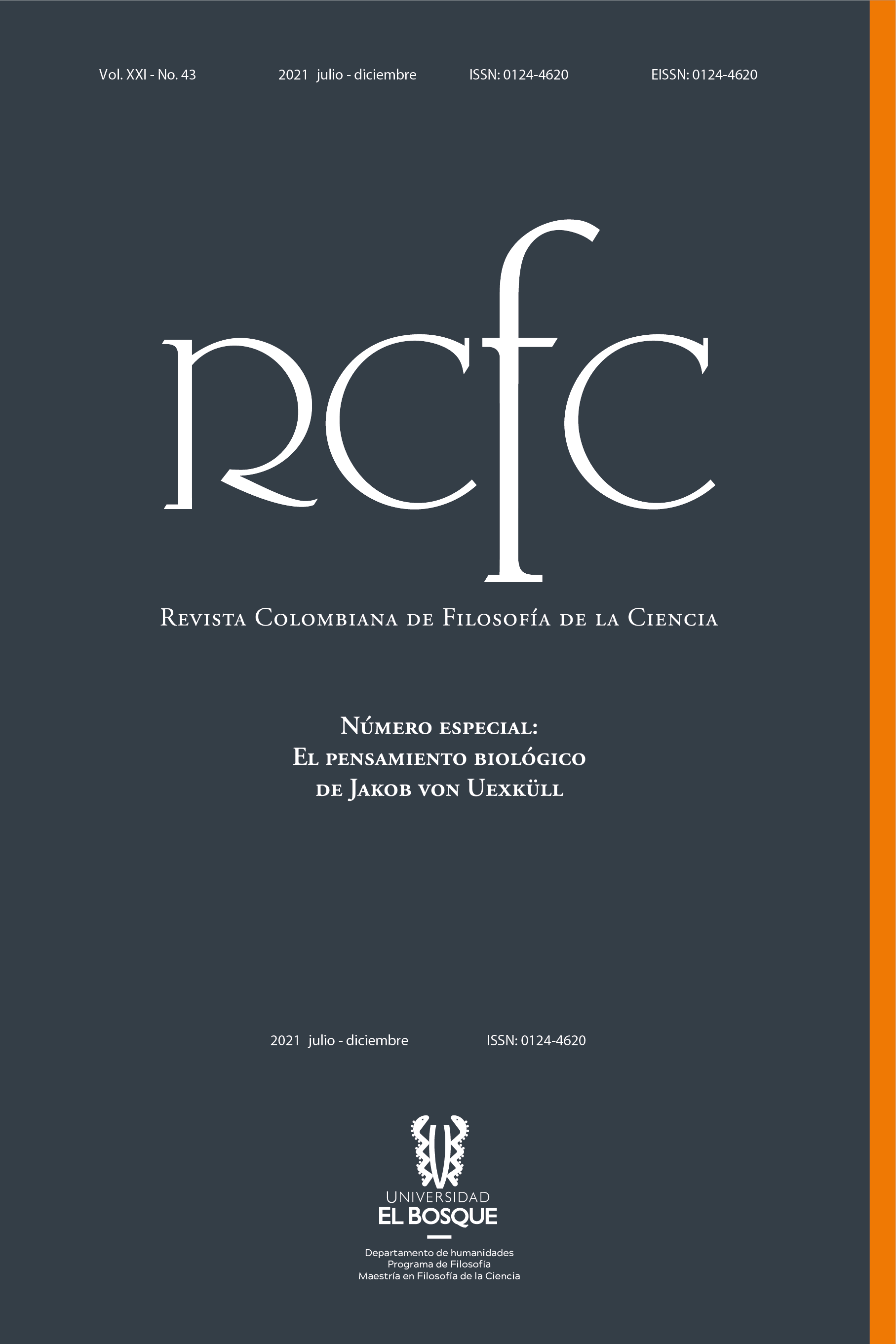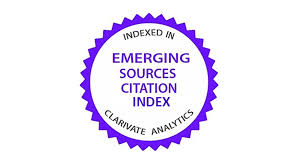A Stroll Through the Umwelt and Performativity
Approaches from Jakob von Uexküll’s Work and Biosemiotics
DOI:
https://doi.org/10.18270/rcfc.v43i21.3462Keywords:
Uexküll, Umwelt, environment, performativity, biosemioticsAbstract
This article ponders on the performative scheme linked to the concept of Umwelt in Jakob von Uexküll, since it is through the endo and exosemiotic activity of the living being that builds its own surrounding world, composed of its own carriers of meaning, and adjusted to their perceptions and behavior. This performative element is one of the aspects that distances the Umwelt from the mere environment, this seen as a neutral, universal space, and indifferent to the various forms of life, about which it maintains a deterministic relationship. On the contrary, the Umwelt is the result of a transcendental and performative process from which the subject shapes the world that surrounds him, in return, it affects the animal, transforming his perception and behavior. Such a performative scheme has important points of agreement with some social and philosophical theories that have made performativity one of the central tools to understand the conformation of subjects and their spheres of life. The works of Erving Goffman and Judith Butler stand out in this area.
Downloads
References
Brentari, Carlo. “Ernst Cassirer’s Reading of Jakob von Uexküll: Between Natural Teleology and Anthropology”. Jakob von Uexküll and Philosophy. Eds. F. Michelini y K. Köchy. Oxford-New York: Routledge, 2020. 106-121.
_______. “How to Make Worlds with Signs. Some Remarks on Jakob von Uexküll’s Umwelt Theory”. Rivista Italiana di Filosofia del Linguaggio7.2 (2013): 8-21. <https://www.doi.org/10.4396/20130701>
Bueno Guerra, Nereida. “How to Apply the Concept of Umwelt in the Evolutionary Study of Cognition”. Frontiers in Psychology 9.1 (2018): 1-3 Online. <https://doi.org/10.3389/fpsyg.2018.02001>
Butler, Judith. El género en disputa. Buenos Aires: Paidós, 2018.
Canguilhem, Georges. La connaissance de la vie. Paris: Vrin, 1992.
Capra, Fritjof. The Turning Point. Science, Society and the Rising Culture. New York: Bantam Books, 1983.
Chamois, Camille. “Les enjeux epistemologiques de la notion d’Umwelt chez Jakob von Uexküll”. Tétralogiques 21 (2016): 171-194. <http://www.tetralogiques.fr/spip.php?article37>
Chang, Han-Liang. “Semiotician or Hermeneutician? Jakob von Uexküll Revisited”. Sign Systems Studies 32.1 (2004):115-138. <https://doi.org/10.12697/SSS.2004.32.1-2.05>
Clauzade, Laurent. “La notion de «fonction» dans la philosophie biologique comtienne”. Revue philosophique de la France et de l'étranger 132.4 (2007): 505-525. <https://www.jstor.org/stable/41100184>
Comte, Auguste. Cours de philosohie positive. Tome III. Paris: Baillieres et fils, 1869.
Crosby, Alfred. La medida de la realidad. La cuantificación y la sociedad occidental, 1250-1600. Barcelona: Crítica, 1998.
De Mauro, Martin. “Tanta vida mutua (mujeres y precariedad animal)”. Alea: Estudos Neolatinos 20.2 (2018): 17-35.<https://doi.org/10.1590/1517-106X/20182021735>
Devillers, Charles. “Éther”. Dictionnaire d’histoire et philosophie des sciences. Paris: Puf, 1999.
Diderot, Denis y Jean Le Rond d'Alembert. Encyclopédie ou Dictionnaire raisonné des sciences. Vol. VI. Paris: Briasson, 1756.
Emmeche, Claus. “Does a Robot have an Umwelt? Reflections on the Qualitative Biosemiotics of Jakob von Uexküll”. Semiotica 134.1/4 (2001): 653-693. <https://doi.org/10.1515/semi.2001.048>
Esparza Arzúa, Gustavo Adolfo. “Ernst Cassirer: una fundamentación biológica de la definición del ser humano como «animal simbólico»”. Open Insight 10.18 (2019): 125-144. <https://www.redalyc.org/journal/4216/421660973006/html/>
Firenze, Antonino. “Lacking what? On the Welt-Umwelt Dichotomy in Heidegger and Gehlen”. Enrahonar. An International Journal of Theoretical and Practical Reason, 63.1 (2019): 39-53. <https://ddd.uab.cat/record/213849>
Gens, Hadrien. Jakob von Uexküll, explorateur des milieux vivants. Paris: Hermann, 2014.
Goffman, Irving. La presentación de la persona en la vida cotidiana. Buenos Aires: Amorrotu, 1997.
Goldstein, Kurt. L’estructure de l’organisme. Paris: Gallimard, 1951.
Kadlecová, Jana y Jaroslav Krbec. “Umwelt Extended: Toward New Approaches in the Study of the Technologically Modified Body”. Journal of Posthuman Studies 4.2 (2020): 178-194. <https://doi.org/10.5325/jpoststud.4.2.0178>
Koffka, Kurt. Principles of Gestalt Psychology. London: Kegan Paul, Trench, Trubner & co., 1935.
Kõvamees, Erik. “Prisons as Total Institution Semiospheres”. Sign Systems Studies 48.2/4 (2020): 297-325. <https://doi.org/10.12697/SSS.2020.48.2-4.06>
Kull, Kalevi. “Uexküll Studies After 2001”. Sign Systems Studies 48.2/4 (2020): 483-509. <https://doi.org/10.12697/SSS.2020.48.2-4.13>
Loeb, Jacques. The Mechanistic Conception of Life. Chicago: The University of Chicago Press, 1912.
Lotman, Yuri. “On the Semiosphere”. Sign Systems Studies 33.1 (2005): 205-229. <https://doi.org/10.2753/rpo1061-0405270140>
Morin, Edgar. La méthode. Paris: Seuil, 2008.
Pollmann, Inga. “Invisible Worlds, Visible: Uexküll's Umwelt, Film, and Film Theory”. Critical Inquiry 39.4 (2013): 777-816. <https://doi.org/10.1086/671356>
Pow, Stephen y Frank W. Stahnisch. “Kurt Goldstein (1878–1965)”. Journal of Neurology 261.1 (2014): 1049-1050. <https://doi.org/10.1007/s00415-013-7020-1>
Rossolatos, Georges. “For a Semiotic Model of Cultural Branding and the Management Dynamic of a Brandosphere in the Face of the Used-Generated Adversiting”. International Journal of Marketing Semiotic 2.1 (2014): 23-47.
Schechner, Richard. Performance Studies: An Introduction. New York: Routledge, 2013.
Schroer, Sara Asu. “Jakob von Uexküll: The Concept of Umwelt and its Potentials for an Anthropology Beyond the Human”. Ethnos. Journal of Anthropology 86.1 (2019): 132-152. <https://doi.org/10.1080/00141844.2019.1606841>
Stjernfelt, Frederik. “Simple Animals and Complex Biology: Von Uexküll's Two-fold Influence on Cassirer's Philosophy”. Synthese 179.1 (2011): 169- 86. <https://doi.org/10.1007/s11229-009-9634-5>
Taine, Hyppolite. Philosophie d l’art. Paris: Hachette, 1909.
Tüür, Kadri y Kristin Armstrong Oma. “Shared Human–Animal Households: The Examples of Nordic Bronze Age Longhouses and Estonian Rehi Houses”. Animal Umwelten In A Changing World: Zoosemiotic Perspectives. Estonia: University of Tartu Press, 2016. 107-136.
Uexküll, Jakob von. Umwelt und Innenwelt der Tiere. Berlin: Julius Springer, 1909.
_______. Theoretical Biology. New York: Harcourt, Brace & Company, Inc., 1926.
_______. Ideas para una concepción biológica del mundo. Madrid: Espasa Calpe, 1934.
_______. Meditaciones biológicas. Madrid: Revista de Occidente, 1942.
_______. A Foray into the Worlds of Animals and Humans.Minnesota: University of Minnesota, 2010a.
_______. Milieu animal et milieu humain. Paris: Rivages, 2010b.
_______. Cartas biológicas a una dama. Buenos Aires: Cactus, 2014.
Viaud, Gastón. Les tropismes. Paris: Puf, 1968.
Von Busch, Otto. Neighbour Hoodies: Courageous Community, Colours, Blazing Bling and Defiant Delight. London: London College of Fashion, 2010.
Downloads
Published
How to Cite
Issue
Section
License

This work is licensed under a Creative Commons Attribution-NonCommercial-NoDerivatives 4.0 International License.

| Article metrics | |
|---|---|
| Abstract views | |
| Galley vies | |
| PDF Views | |
| HTML views | |
| Other views | |











